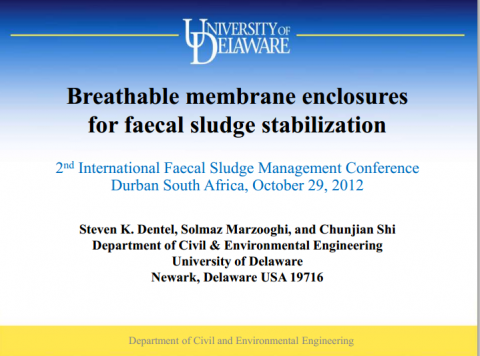This library entry contains background documents for a grant that Steven Dentel is leading and which is funded by the Bill and Melinda Gates Foundation.
Further information and a discussion is available on the SuSanA discussion Forum, see link below.
We’re using “breathable membranes” to improve the performance and usability of basic latrines. Unlike most membranes used in environmental applications, these are hydrophobic in nature, which means they block the passage of liquid water and anything dissolved or suspended in the water, including pollutants and pathogens. However, they do allow water vapor to pass through. Because of this property, the membranes can be used as a latrine pit enclosure, allowing the sludge to dry while the heat from intrinsic biodegradation or from solar heat gradually expels water vapor, but preventing escape of particulate or dissolved constituents. This enables the protection of groundwater or floodwaters near the latrine pit, as well as the health of workers who often must empty filled pits under unsanitary conditions.
The breathable membrane is primarily intended to be used as an enclosure in waterless basic pit toilets worldwide, but its applications can be extended to uses in toilets with/without urine diversion, pumped latrine wastes, combined with other evolving toilet technologies, and commercial applications at larger scale.
The goal of this project is to test the use of breathable membranes to protect surrounding groundwater or floodwaters from contamination, while allowing fecal sludge to condense and stabilize. We have verified the concept and are now quantifying the drying rates under differing conditions. We’re also running experiments with “mini-latrines” to observe behavior under fairly realistic conditions.
Our tests started out with more idealized experiments, using wastewater sludge enclosed in “envelopes” of the membrane material, only 100 square cm in area. We found the that drying process is rapid, even with temperature differences of only 2 degrees. Seeing how fast the sludge dries in our experiments was almost unbelievable. Our most exciting results are that the membrane does not impair the drying very much, even while retaining contaminants, and that the membrane does not clog at all, so the drying rate is fairly constant and the membrane can easily be re-used. We’ve also found most of the breathable membranes to be quite strong, so they may allow withdrawal of the fecal sludge while it is contained in the membrane enclosure.
Our small-scale experiments are idealized, however. We have graduated to more complicated test systems to examine a wider range of conditions. For example, we have a dual-thermostatted setup to observe moisture movement from sludge on one side of the membrane into water on the other. This has been used to determine transfer rates with a variety of membrane types and temperature differences. We are now working with what we call “mini-latrines—about 1/10th scale—to observe drying in a 3-dimensional system that simulates field conditions.
Authors:
Dentel, S. K., Marzooghi, S., Shi C. J.
Start and end date: November 2011 until October 2013
+++++++++++
Documents available for download below:
1 - Breathable membrane enclosures for faecal sludge stabilization (paper at FSM2 Conference in Durban, South Africa, Oct. 2012)
2 - Breathable membrane enclosures for faecal sludge stabilization (presentation at FSM2 Conference in Durban, South Africa, Oct. 2012)
3 - Short presentation by Steve Dentel for webinar on Vapor-permeable membranes: Three potential uses in faecal sludge management for safe sanitation and resource recovery (Feb. 2014)
4 - Presentation on improvement of faecal sludge dewatering and drying by incorporation of a breathable membrane
latrine liner by Shray Saxena, Dr. Steven Dentel, Babak Ebrazi, Dr. Paul Imhoff. FSM3 Conference in Hanoi, Vietnam, Jan. 2015)
Bibliographic information
Dentel, S. (2013).
Breathable membrane enclosures for fecal sludge stabilization Various documents on results from research grant University of Delaware, USA
Filter / Tags
Fundamental research and engineeringEnglish
External links
Further information on discussion forum
Downloads
1 - Breathable membrane enclosures for faecal sludge stabilization (paper at FSM2 Conference in Durban, South Africa, Oct. 2012)
Download
Type: application/pdf
Size: 0.7 MB
2 - Breathable membrane enclosures for faecal sludge stabilization (presentation at FSM2 Conference in Durban, South Africa, Oct. 2012)
Download
Type: application/pdf
Size: 1.43 MB
3 - Short presentation by Steve Dentel for webinar on breathable membrane project (Feb. 2014)
Download
Type: application/pdf
Size: 1.36 MB
4 - Presentation on improvement of faecal sludge dewatering and drying by incorporation of a breathable membrane latrine liner (FSM3 Conference in Hanoi, Jan.2015)
Download
Type: application/pdf
Size: 1 MB

